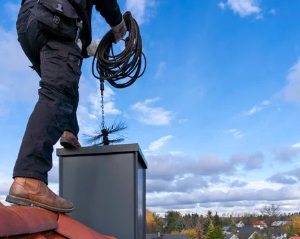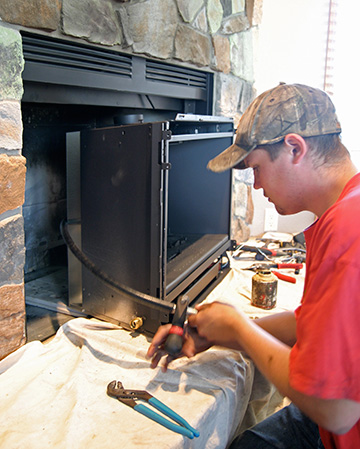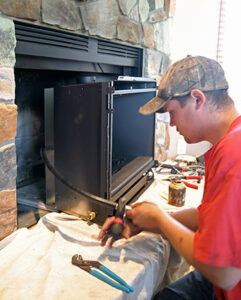Chimney Repair Baltimore can range from simple and quick to complex and time-consuming. Knowing when to call a professional will help minimize the repair cost. Look for rust on metal components like the damper and flue liner. Rust can cause problems, including excessive moisture that leads to spalling and freeze-thaw damage.
Several things, including flooding from heavy rain, a chimney flue leak, or a damaged masonry structure, can cause water damage. Whatever the source of the leak, it is important to contact a masonry repair professional as soon as possible. Leaving these issues unrepaired can lead to mold growth, chimney failure, and costly structural damage. Homeowners can help prevent these issues by regularly inspecting their chimneys, installing a chimney cap to keep debris and rain from entering the fireplace, and promptly repairing any signs of damage.
Cracks in the chimney crown are another common problem that should be repaired immediately. The chimney crown is a sloping cement layer that covers the top of the masonry section of the chimney. This surface is designed to protect the masonry from moisture but will crack and deteriorate over time. Chimney professionals can repair these areas by coating them with a waterproof sealant. A full replacement may be required if the chimney crown is severely damaged.
Another common cause of water damage is cracked, missing, or corroded flashing. The flashing is the metal strip that connects the roof and the chimney. A chimney repair expert will inspect the flashing for any signs of rust or corrosion and replace or repair any corroded sections. Chimney repair experts can also use a special caulking compound to fill gaps between the chimney and roof.
The chimney liner is a crucial part of the chimney, as it directs smoke, gases, and other dangerous byproducts out of the home. If the chimney liner is cracked or damaged, carbon monoxide can enter the home. This poisonous gas is colorless and odorless, making it hard to detect without the help of a specialized detector. Chimney repair specialists can replace a damaged chimney liner with a new one or repair the existing one using a technique known as slip casting.
While homeowners need to sweep their chimneys regularly and monitor them for signs of deterioration, they should never attempt to repair them themselves. Fixing problems like minor cracks or a leaning chimney can be extremely dangerous. It is recommended that homeowners only seek the services of a qualified and experienced masonry repair professional to avoid any serious problems.
Mortar joints take the brunt of wall movement, foundation settlement, and exposure to weather. Mortar provides a buffer between bricks designed to crack and deteriorate before the brick itself. Still, excessive moisture damage can lead to mortar joint cracks that allow water into the home or chimney structure. Water seeping through damaged mortar joints can cause mildew growth and other issues, including structural instability, mold, and wood rot.
Traditional tuckpointing replaces deteriorated mortar with new lime-based mortar to preserve the historic brick and repair the chimney’s integrity. Mortar joint repair can be a DIY project for those with some masonry experience. Still, it’s usually best to hire a professional, especially on larger buildings or structures requiring access to safety equipment.
One way to check if the brick mortar on your building is deteriorating is by running a screwdriver or hammer along the mortar edge. If the mortar is easily scratched, it’s time to call in a professional to replace the softened mortar. Another sign is if the mortar is crumbling or the joint depth is more than 1/4″ from its original level.
Several things can cause cracks in the mortar, but the most common cause is excess moisture entering the masonry walls and freezing as it expands. Moisture that enters the masonry and freezes repeatedly can eventually lead to spalling when large chunks of mortar break off the brick and cause further water damage.
The good news is that if you catch the problem early, it’s relatively inexpensive to correct. A mortar joint sealant from most hardware stores can be applied to the deteriorating mortar joints to prevent moisture penetration and protect the chimney from further damage.
To apply the caulk:
- Widen the crack to at least a quarter inch with a hammer and chisel and clean the area of any loose debris or dirt that could interfere with the bonding process.
- Cut the caulk’s nozzle tip to match the crack’s width and load it into a standard caulk gun.
- Slowly draw the gun against the surface, forcing a bead of the caulk into the crack.
Brick chimneys experience much more exposure and wear and tear than other masonry structures in your home. They also have to contend with harsh indoor and outdoor environments, making them prone to damage earlier than other areas of your home. Chimney masonry that experiences severe damage will eventually begin spalling, which can result in leaks and structural problems.
When bricks spill, getting them repaired as soon as possible is important. This will not only prevent the damage from worsening but also help preserve the rest of your chimney structure. A breathable sealant can be applied to the damaged area of your chimney to keep moisture away and stop it from further damaging your masonry.
Several factors can affect brick spalling, including weather, mortar quality, craftsmanship, and age. Older bricks may be softer and need more glazing to help them resist the elements. Poor construction and salvaged bricks can also start spalling sooner than high-quality, newer bricks and masonry.
The first step in repairing loose bricks is to chip away the old mortar using a cold or flat utility chisel and short, light hammer blows. Next, you’ll need to clean the exposed area of your chimney and sand the open space down with a wire brush to improve mortar adhesion. It’s also a good idea to dust off the area with a broom and dampen it with water to increase mortar adhesion.
Once the area is cleaned and prepared, you must prepare your replacement brick. Get a matching brick and mix your mortar, following the manufacturer’s directions or standard sand, cement, and water ratios. You use a trowel to “butter” the bottom and sides of your replacement brick before pushing it into place. Ensure that the new brick is leveled and centered in the hole before applying more mortar to finish it off.
Keeping up with regular maintenance and checking for signs of damage is the best way to reduce spalling and other problems. Having a professional chimney sweep inspect your chimney annually will help to catch many issues before they have the chance to escalate and cause more costly damage.
The chimney crown is a slab of concrete that covers the top opening and keeps rain out of the flue, sparks from landing on the roof, and other debris from damaging the brick and mortar. Cracks in the crown can compromise the integrity of your chimney and lead to extensive structural damage, requiring a rebuild or removal. Chimney masonry experts recommend regularly inspecting the chimney to catch small cracks early and repair them before they worsen.
Repairing a cracked crown costs less than replacing it entirely, but it is still high enough to require careful planning. Hiring a professional for this project is best, as working on the roof for masonry work is complex and potentially dangerous. Masonry professionals use special equipment and knowledge of safety practices to ensure a safe and thorough job. They also have the specialized skills necessary to perform impossible repairs at home.
Depending on the size of your chimney and the extent of the damage, the average re-mortaring costs from $150 to $500. This process involves removing and replacing damaged sections of chimney mortar to prevent further cracking. Chimney re-mortaring is most effective before the mortar cracks and crumbles, which can usually be prevented with routine maintenance.
A deteriorating chimney crown can cause serious structural problems that could result in the collapse of your chimney, expensive water damage to your home’s ceiling and walls, or other dangerous issues. Chimney experts recommend having it repaired as soon as you notice a crack.
Chimneys are essential to a comfortable, safe home but need regular care and maintenance to function properly. By keeping up with routine inspections, you can protect your investment and spend more time relaxing and enjoying family gatherings by the fireplace. If you see signs of chimney problems, contact an experienced mason as soon as possible for a prompt and affordable repair. This will help you save money in the long run and ensure your chimney operates safely and efficiently.

